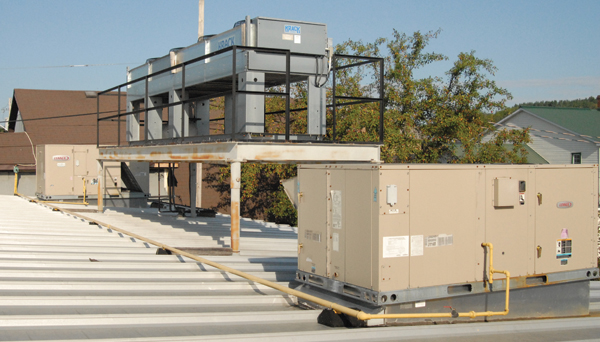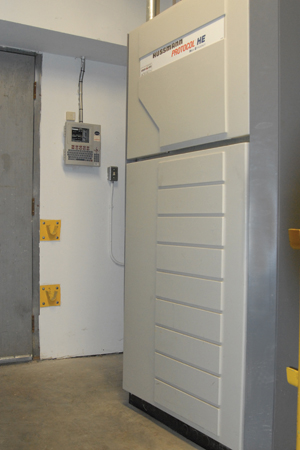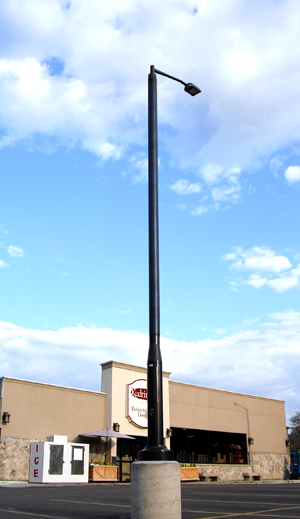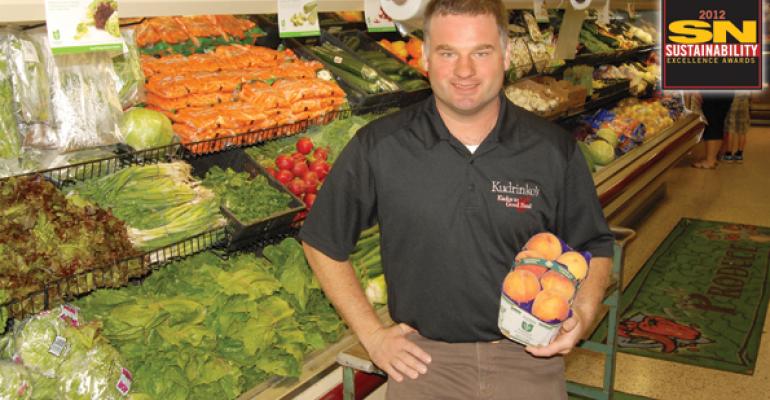For Neil Kudrinko, owner of Kudrinko’s, a one-store operation in Westport, Ontario, the money he is saving because of store enhancements has become “a very addictive thing.”
Since taking over management of the 22-year-old family business from his father in 2005 (and ownership in 2010), Kudrinko, 37, has set an ambitious course for his 10,200-square-foot store. The myriad changes include a major overhaul of its physical infrastructure, new refrigeration and HVAC systems (below left), LED lighting retrofits, humidity controls, a parking lot reconstruction that controls rainwater, and solar parking lot lighting, among other changes.
The resulting efficiencies have led to a virtuous cycle — the more money he cuts from his energy bill, for example, the more he is incented to continue to make investments, paying for new systems with money already saved. “You see this and you want more,” he said. “How much more savings can I create in my store? The worst thing I could do is stop spending money,” he added, laughing.
 Kudrinko combines a grocer’s hard-nosed approach to business with a politician’s desire to improve society. A graduate of Carleton University, Ottawa, with a degree in political science, he ran as a Green Party candidate for provincial parliament in Ontario in 2010, promoting his store’s environmental initiatives, but lost in a very conservative district. “I’m a political person,” he said. “I enjoy public policy.” And he likes seeing how businesses can be part of the solution to environmental problems. “If every grocery store in Canada made the kind of investments I made, we’d reduce carbon emissions substantially,” he said.
Kudrinko combines a grocer’s hard-nosed approach to business with a politician’s desire to improve society. A graduate of Carleton University, Ottawa, with a degree in political science, he ran as a Green Party candidate for provincial parliament in Ontario in 2010, promoting his store’s environmental initiatives, but lost in a very conservative district. “I’m a political person,” he said. “I enjoy public policy.” And he likes seeing how businesses can be part of the solution to environmental problems. “If every grocery store in Canada made the kind of investments I made, we’d reduce carbon emissions substantially,” he said.
But he’s also very pragmatic about the economic impact of environmental investments. “When I talk to other grocers about changes we’ve made, I very rarely discuss is it good for the environment,” he said. “I look at the business benefits. And for us it’s making sure our store can compete with stores that have these [energy-saving] technologies in place.”
Kudrinko is more than holding his own. In calendar year 2011, using the Carbon Counted website, he calculated that his store generated 55% less carbon dioxide equivalents through electricity and propane usage, as well as refrigerant emissions, than the average store of his size in Canada. Between 2008, when he began renovating his store, and 2011, his overall carbon footprint has dropped from 16.60 to 10.57 kilograms of CO2-equivalent per square foot.
Read more: Curbing Carbon: SN Sustainability Excellence Awards
He accomplished this in a store originally built in 1964. “It goes to show that despite the building being old, it doesn’t mean you can’t put in place investments with a profound effect,” he said. The carbon calculation, which he has done for five years, is part of the Environmental Sustainability Project launched for Canadian independents by the Federation of Independent Grocers.
For his wide-ranging environmental initiatives and store improvements, Kudrinko’s has been selected to receive SN’s 2012 Sustainability Excellence Award in the independent category.
Major Renovation
Kudrinko began the major upgrade of his store and its energy and refrigeration components in 2008, a process that took about two years, at a combined cost of about $600,000. To make the cost more palatable to his dad, still the owner at that time, and manageable for himself, Kudrinko spread the renovation over two years and multiple contractors. “We did it one project at a time so we could see the results,” he said. “I would say [to his father], in order to maximize the potential of the renovation and maximize the payback, we can’t stop half-way. We need all the systems working together.”
Kudrinko considered building an entirely new store but decided to stick with his existing building, even though that was a more challenging choice. “If you have a structurally sound building, there’s a lot to be said for working with what you have,” he said. “You already have the ecological footprint — all the cement and steel.” Retailers who choose to build a replacement store “should be cognizant of the ecological impact of walking away from that.” He also valued the downtown location of his existing store.
Kudrinko acknowledged that it is difficult to look at the store renovation as a whole and precisely forecast the payback period for his investment, adding that, given the magnitude of the overhaul, the payback could be 10 to 15 years. “You have to have some faith that we’re going to do this and it’s going to work out,” he said. “And it certainly has worked out.” For evidence of that, he points to his energy costs, which since 2008 have stabilized, even though the price of energy has continued to rise. By comparison, during the previous five years, his energy costs almost doubled. “I’m probably saving easily $25,000 to $30,000 in energy costs annually,” he said.
Maintenance costs have dropped $20,000 to $25,000 per year. “Now that the systems work efficiently together, we’re seeing very few maintenance calls,” he said. He also attributes that to the better air quality in the store, which puts less stress on his compressors.
 One of the more remarkable upsides for Kudrinko has been the installation of a back-room Hussmann Protocol refrigeration system (left) that has yet to spring a refrigerant leak in three years. (It uses R-404A refrigerant.) He credits his refrigeration contractor, Hamilton Smith, Belleville, Ontario, for doing a good installation job. “It cost more to install than to buy, but if that’s the kind of operation you get, you don’t mind,” he said. His only refrigerant loss this year was two pounds of R-22 from his office air conditioning system.
One of the more remarkable upsides for Kudrinko has been the installation of a back-room Hussmann Protocol refrigeration system (left) that has yet to spring a refrigerant leak in three years. (It uses R-404A refrigerant.) He credits his refrigeration contractor, Hamilton Smith, Belleville, Ontario, for doing a good installation job. “It cost more to install than to buy, but if that’s the kind of operation you get, you don’t mind,” he said. His only refrigerant loss this year was two pounds of R-22 from his office air conditioning system.
Kudrinko previously used a standard DX refrigeration system with two pipes coming out of each of its compressors. By contrast, the Protocol unit, containing six scroll compressors, has only two pipes going out to all medium-temperature and low-temperature cases. The DX unit had “much more piping, many more joints and welds, and therefore more potential for leaks and equipment failures,” he said.
To supplement the capacity of the Protocol system, Kudrinko also has a rooftop compressor supporting his fresh meat counter and another rooftop compressor for his walk-in freezer. For his frozen food cases, Kudrinko recently replaced fluorescent lighting in 21 doors with Immersion RV40 LED lights from GE Lighting Solutions, from which he expects a 2.4-year payback after rebate.
Read more: Unified Grocers Finds Sustainability Inspiration From Within
Kudrinko has also upgraded his HVAC technology, replacing an oil-based system with a two-unit Lennox L series system that uses less expensive and more environmentally friendly propane and is more energy efficient. He also installed a custom-built coil in the Lennox system that reclaims heat from the refrigeration unit, thereby supplementing the propane fuel.
Next to the store, Kudrinko built a 800-square-foot receiving warehouse (cost: $100,000) with a roof that could support the condenser for the Protocol system and the new HVAC system. He also rewired the store and upgraded the electrical service from 400 to 600 amps.
Humidity Issue
One of Kudrinko’s biggest sustainability projects was addressing the “super high humidity” in his store during the summer, something that affected both the store environment and the efficiency of the refrigeration system. One step was to replace the R-8 insulation in the roof with R-40 insulation along with a new roof (cost: $50,000). That was followed by the removal of the dropped ceiling in the retail space of the store and installation of ceiling fans to achieve better air quality and reduce humidity. Plus, the new HVAC system contains a Humiditrol dehumidification feature. He also installed an air curtain at the front entrance to reduce heating/cooling loss.
 By controlling the humidity in the store, Kudrinko has reduced the frequency of frozen-food-case defrosting during the summer from two or three random times to occasional planned maintenance. This in turn results in fewer “perceived out-of-stocks” in the freezers and better sales, he said.
By controlling the humidity in the store, Kudrinko has reduced the frequency of frozen-food-case defrosting during the summer from two or three random times to occasional planned maintenance. This in turn results in fewer “perceived out-of-stocks” in the freezers and better sales, he said.
In his parking lot, Kudrinko installed two solar light poles with LED lamps (left), from Inovus Solar, Boise, Idaho. The poles contain solar collectors that power the lamps; motion sensors determine the intensity of the light. “It doesn’t light to highway standards, but it certainly is more than bright enough for a parking lot,” he said.
The parking lot also contains a “swale,” or a depressed area near the curb where rainwater can be diverted and absorbed into the soil beneath the lot rather than running off into the street, which borders a lake. “We’re cautious about the potential for putting contaminants into the lake,” said Kudrinko. Rainwater from the roof is also diverted beneath the ground of the parking lot.
Read more: Sobeys Progresses Toward Carbon, Waste-Diversion Goals
Kudrinko actively promotes local foods, including produce and hormone- and antibiotic-free Angus beef. In addition to holding a fall harvest sale, he is helping local farmers find better distribution for their products. “We’re working with farmers to look at cooperatives to get more products into stores,” he said.
| Suggested Categories | More from Supermarketnews |
 |
|

|
|





